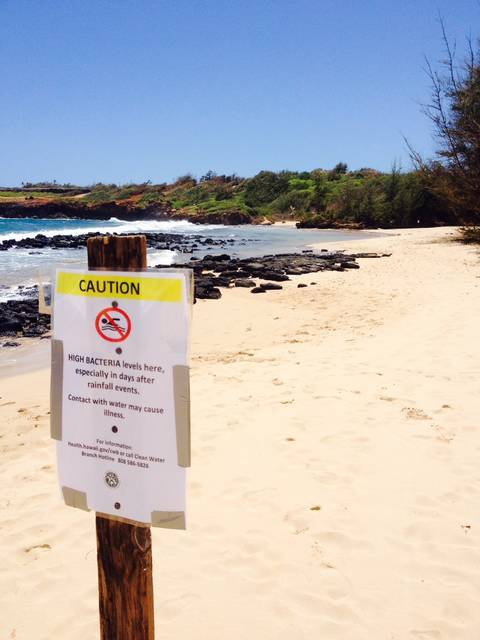HANALEI — Water quality has cleaned up in some areas on Kauai’s North Shore after the April floods, but the state Department of Health still has a brown water advisory for some places on the island.
Scientists with the Kauai Surfrider Blue Water Task Force released their latest test results May 12, with 19 of the 34 sampling sites returning enterococcus bacteria counts above the state threshold.
That threshold is 130 parts of bacteria per 100 mL of water.
“Many areas on the North Shore have cleaned up,” BWTF members said. “Other streams continue to have bacteria counts. Some streams are chronically polluted.”
In the days following the April floods, DOH had a brown water advisory for the entire island, but now that advisory is only for Koloa Landing, Hanamaulu Beach and Waikoko to Wainiha.
DOH and the BWTF sample at different locations, and in those same days following the flood BWTF members did testing at 12 locations. Five of them came back with bacteria counts above the state threshold.
Those locations were Hanamaulu Beach, Waikomo Stream, Koloa Landing, Kealia Beach and Middles Beach in Hanalei Bay.
On May 12, water quality at Kealia was clean, according to state standards. Hanamaulu’s numbers were higher, taking a jump from 426 parts/100 mL to 609 parts per 100 mL on the day of the sampling.
Geometric mean — a combination of more than five samples — at Hanamaulu Stream are 1,136 parts per 100 mL, far above the state standard.
Wainiha Stream tested at 93.3 for the geometric mean, and Waikoko’s geomean is 10, below the state threshold.
Clean water can be found at Waiohai and PK’s in Poipu; Pinetrees, The Pier, The Bowl, and Waikoko in Hanalei; Kalapaki Bay and Kapaa Beach, Salt Pond Beach Park, Major’s Bay and Kealia Beach Park.
“Bacteria levels in the Hanalei River and at the pier are well below beach action values (state threshold) and do not require warning signs,” said Carl Berg, head of BWTF.
That’s because high flow rates dilute the bacteria, but that’s not the case for the smaller streams like Kilauea, Kalihiwai, Moloaa, Waikomo and Waiopili.
“Bacteria concentration in the thousands are very concerning,” Berg said.
While scientists are testing the water in streams and surf breaks around Kauai for high bacteria counts, testing of the sand — particularly at Hanalei Bay — hasn’t been done.
Days after the flooding, residents and visitors alike started complaining about the smell of the sand in Hanalei Bay.
DOH advised: “if an area smells like it is contaminated by sewage or other foul-smelling materials, it can be assumed to be contaminated.”
Berg says there’s a good chance that much of the bacteria contaminating the sand is gone, but there will generally be some level of bacteria in the sand — flood or not.
“While the sand may be polluted with bacteria, constant wave action would flush the bacteria out and sunlight should kill the bacteria load at the surface of the sand,” Berg said. “There will always be bacteria growing in the sand, so definitely don’t eat it.”
•••
Jessica Else, environment reporter, can be reached at 245-0452 or jelse@thegardenisland.com.


